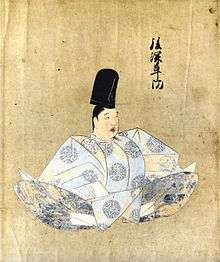Emperor Go-Fukakusa
| Go-Fukakusa | |
|---|---|
| Emperor of Japan | |
 | |
| Reign | 1246–1260 |
| Predecessor | Go-Saga |
| Successor | Kameyama |
| Born | June 28, 1243 |
| Died | August 17, 1304 (aged 61) |
| Burial | Fukakusa no kita no Misasagi (Kyoto) |
| Spouse | Fujiwara no Kimiko |
Emperor Go-Fukakusa (後深草天皇 Go-Fukakusa-tennō) (June 28, 1243 – August 17, 1304) was the 89th emperor of Japan, according to the traditional order of succession. This reign spanned the years 1246 through 1260.[1]
This 13th-century sovereign was named after the 9th-century Emperor Nimmyō[2] and go- (後), translates literally as "later;" and thus, he could be called the "Later Emperor Fukakusa". The Japanese word go has also been translated to mean the "second one;" and in some older sources, this emperor may be identified as "Fukakusa, the second," or as "Fukakusa II."
Name
Before his ascension to the Chrysanthemum Throne, his personal name (his imina) was Hisahito (久仁).[3]
Although the Roman-alphabet spelling of the name of this 13th-century emperor is the same as that of the personal name of a current member of the Imperial family, the kanji are different:
- Emperor Go-Fukakusa, formerly Prince Hisahito (久仁)
- Prince Hisahito of Akishino (悠仁)
He was the second son of Emperor Go-Saga.
Issue
- Empress: Saionji (Fujiwara) Kimiko (西園寺(藤原)公子) (daughter of his mother's younger sister and Emperor Go-Saga's adopted son/nephew)
- Second daughter: Imperial Princess Takako (貴子内親王)
- Third daughter: Imperial Princess Reiko (姈子内親王) (wife of Emperor Go-Uda)
- Lady-in-waiting: Daughter of Miki? (Fujiwara) ?? (三木(藤原)茂通)
- Eighth son: Prince ?? (三木(藤原)茂通) (Buddhist Priest)
- Sixth daughter: Imperial Princess ?? (永子内親王)
- Consort: Tōin (Fujiwara) ?? (洞院(藤原)愔子)
- Fourth daughter: Imperial Princess Hisako (久子内親王)
- Second son: Imperial Prince Hirohito (熈仁親王) (Emperor Fushimi)
- Third son: Prince ?? (性仁法親王) (Buddhist Priest)
- Consort: Miki? (Fujiwara) Fusako (三条(藤原)房子)
- Fifth son: Prince Gyōkaku (行覚法親王) (Buddhist Priest)
- Seventh son: Imperial Prince Hisaaki (久明親王) (8th Shōgun of Kamakura Shogunate)
- Ninth son: Prince ?? (増覚法親王) (Buddhist Priest)
- Consort: Saionji (Fujiwara) Aiko (西園寺(藤原)相子)
- Fifth daughter: Princess Hanako/Eiko/Akiko (瑛子内親王)
Events of Go-Fukakusa's life
Hisahito-shinnō (久仁親王) formally became Go-Fukakusa-tennō (後深草天皇) at the age of 2; and Go-Saga began to exercise power as cloistered Emperor.
- 1247 (Kangen 4, 1st month): In the 4th year of Go-Saga-tennō 's reign (後嵯峨天皇四年), he abdicated; and despite the succession (‘‘senso’’) was received by his 4-year-old son. Shortly thereafter, Emperor Go-Fukakusa is said to have acceded to the throne (‘‘sokui’’).[4]
In 1259, at the insistence of Retired Emperor Go-Saga, he abdicated at the age of 15 to his younger brother, who would become Emperor Kameyama.
After Emperor Go-Uda's ascension in 1260, Saionji Sanekane negotiated with the Bakufu, and succeeded in getting Emperor Go-Fukakusa's son Hirohito named as Crown Prince. In 1287, with his ascension as Emperor Fushimi, Go-Fukakusa's cloistered rule began.
In 1290, he entered the priesthood, retiring from the position of cloistered Emperor. But, with his seventh son, Imperial Prince Hisaaki becoming the 8th Kamakura shōgun among other things, the position of his Jimyōin-tō became strengthened.
In 1304, he died. He is enshrined with other emperors at the imperial tomb called Fukakusa no kita no misasagi (深草北陵) in Fushimi-ku, Kyoto.
Kugyō
Kugyō (公卿) is a collective term for the very few most powerful men attached to the court of the Emperor of Japan in pre-Meiji eras. Even during those years in which the court's actual influence outside the palace walls was minimal, the hierarchic organization persisted.
In general, this elite group included only three to four men at a time. These were hereditary courtiers whose experience and background would have brought them to the pinnacle of a life's career. During Go-Fukakusa's reign, this apex of the Daijō-kan included:
- Sesshō, Ichijō Sanetsune, 1246–1247
- Sesshō, Konoe Kanetsune, 1247–1252
- Sesshō, Takatsukasa Kanehira, 1252–1254
- Kampaku, Takatsukasa Kanehira, 1254–1261
- Sadaijin
- Udaijin
- Nadaijin
- Dainagon
Eras of Go-Fukakusa's reign
The years of Go-Fukakusa's reign are more specifically identified by more than one era name or nengō.[5]
- Kangen (1243–1247)
- Hōji (1247–1249)
- Kenchō (1249–1257)
- Kōgen (1256–1257)
- Shōka (1257–1259)
- Shōgen (1259–1260)
See also
Notes

- ↑ Titsingh, Isaac. (1834). Annales des empereurs du Japon, p. 248-255; Varley, H. Paul. (1980). Jinnō Shōtōki. p. 231-232.
- ↑ Varley, p. 237; n.b., Fukakusa was an alternate name for Emperor Nimmyō.
- ↑ Titsingh, p. 248; Varley, p. 231.
- ↑ Titsingh, pp. 247–248; Varley, p. 44; n.b., a distinct act of senso is unrecognized prior to Emperor Tenji; and all sovereigns except Jitō, Yōzei, Go-Toba, and Fushimi have senso and sokui in the same year until the reign of Emperor Go-Murakami.
- ↑ Titsingh, p. 248.
References
- Ponsonby-Fane, Richard Arthur Brabazon. (1959). The Imperial House of Japan. Kyoto: Ponsonby Memorial Society. OCLC 194887
- Titsingh, Isaac, ed. (1834). [Siyun-sai Rin-siyo/Hayashi Gahō, 1652], Nipon o daï itsi ran; ou, Annales des empereurs du Japon. Paris: Oriental Translation Fund of Great Britain and Ireland.
- Varley, H. Paul , ed. (1980). [ Kitabatake Chikafusa, 1359], Jinnō Shōtōki (A Chronicle of Gods and Sovereigns: Jinnō Shōtōki. New York: Columbia University Press. ISBN 0-231-04940-4
External links
| Regnal titles | ||
|---|---|---|
| Preceded by Emperor Go-Saga |
Emperor of Japan: Go-Fukakusa 1246–1260 |
Succeeded by Emperor Kameyama |
